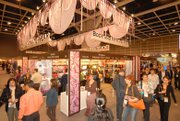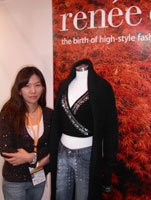World Market
A contingent of California companies are among the many exhibitors testing the expanded Hong Kong Fashion Week.
HONG KONG—Now in its 37th year, the biannual Hong Kong Fashion Week is experiencing growing pains. This season, there were 1,330 exhibitors, up 22 percent from a year ago, at the Fall/Winter 2006 trade fair, held Jan. 17–20 at the Hong Kong Convention and Exhibition Centre.
World Boutique, a 3-year-old satellite show for brand names and designers, grew to 232 exhibitors, compared to last year’s 194.
With so many companies coming for the four-day event, show organizers for the first time opened up Hall 7 on the top floor of the cavernous exhibition center that overlooks Victoria Harbor. But the 364 Chinese exhibitors shifted to this location were not pleased being in a region that was like exhibiting in the upper stratosphere of space. “Even I lost my way getting here,” said Mr. John, sales manager for the Shenzhen Little Goat Cashmere Co. Ltd. in China.
Show organizers tried to direct more traffic to the upper hall by handing out free coffee coupons that could only be redeemed in that far-flung location. In addition, attractive women walked up and down the main floor carrying placards that read: “More Exhibitors in Hall 7.”
Location was a top priority for Renee Song, president of So Cool Inc., a Los Angeles company that makes contemporary women’s sweaters, woven tops and bottoms under the Renee C. label. This was the company’s second time at Hong Kong Fashion Week.
So Cool had a booth at the front of one of the gigantic exhibition halls that holds hundreds of booths. Song’s space was big enough to display the 300 sweaters and other items she brought from Los Angeles. “Last summer we were in the middle of the row,” said Song, who is the line’s designer and a graduate of Otis College of Art + Design in downtown Los Angeles.
The better location helped her company get an order for 7,000 sweaters from an Egyptian buyer. But that was one of the few orders she made at the show. “We won’t know about the total until we get home. So many people have asked for samples and prices,” she noted.
Still, many exhibitors felt that buyer attendance was down from last January’s show. Much of that was due to the temporary quotas imposed by the United States and Europe on Chinese- made apparel and textiles. The quotas are in place until the end of 2008 and 2007 respectively. The Hong Kong Trade Development Council, which organizes the show, said attendance was 23,572 this year, compared to 25,401 last year.
Organizers noted that the show dates fell close to Chinese New Year (Jan. 29), which contributed to a decrease in visitors from Mainland China and Taiwan.
Vikas Agarwal, president of Aman Exports International, a clothing manufacturer with 1,000 workers in Jaipur, India, saw a major decrease in buyers and business.
Last January, Agarwal had orders for 300,000 pieces of the company’s brightly colored tops and skirts sold to retail chains such as Forever 21 in Los Angeles. At the July show, he wrote orders for 200,000 items. This season, he had orders for only about 30,000 pieces. “This year is very quiet. It is not up to expectations,” said the head of the company, who took five booth spaces this season instead of three, thinking it would be another banner show.
Agarwal was one of 135 Indian garment manufacturers brought to the show with the help of India’s Apparel Export Promotion Council. One year ago, the council brought 69 companies. The big boost came after glowing reports of the January 2005 show.
Lance Yuan, a salesman with Ningbo Sedung Group Co. Ltd., a 10-year-old company with 3,000 workers who make knit shirts, jackets and other sportswear sold to such stores as Zara in Spain and H&M in Europe and the United States, was holding out hope that sales at the show would increase 10 percent over last year, as they have done every year since the company launched and has exhibited at Hong Kong Fashion Week. “Many customers visit this exhibition, so this exhibition is very good,” he said.
The California contingent
Up at the World Boutique, traffic picked up for a small contingent of L.A. garment manufacturers after a wobbly beginning.
Los Angeles designer Randa Allen was one of seven apparel companies exhibiting their Los Angeles–made apparel at World Boutique during Hong Kong Fashion Week. Allen and her fellow designers arrived that first day to discover their cluster of booths hidden by a towering plywood wall that separated the pink-and-black catwalk from their cluster of booths. The result was a cul-de-sac located among the maze of booths surrounding the pink carpeted runway. Not very conducive to generating buyer traffic.
“It would be one thing if we had signed up at the last minute, but we’ve been planning this for weeks,” said Frances Harder, the coordinator of the trip, who also presented a seminar on branding apparel to a packed room of young Chinese entrepreneurs and designers. Harder, as executive director of Fashion Business Inc., a 7-year-old nonprofit in Los Angeles that helps new and small designers jump-start their companies, had spent months putting the trip together.
After much complaining, the great wall came tumbling down after that first day. American flags went up to advertise the group’s location. The show organizers did a small story on the California group in the Fair Daily newspaper distributed to all the buyers. Everyone was happier.
“This is so much better,” said Allen, who was showing her four labels—Notice, Noticeable, Poet Tee and Take a Seat—for the first time in Hong Kong. Her contemporary labels encompass dresses, skirts, tops, pants and T-shirts. Other L.A. designers exhibiting were childrenswear companies Porky Pies and Kidcosmic and contemporary womenswear lines Frankie B., Murielle, Signorelli and Zara Jeans.
Once the wall came down, business was up.
A distributor from Singapore was talking about placing big orders with several of the L.A. firms after she was assured that their collections were made in the United States.
She asked Allen if she could perhaps fill a container with her Poet Tee T-shirts that have the currently popular groundat- the-edges, over-washed look.
The distributor was also talking to Richard Freund, general manager of Frankie B., known for its very-low-rise jeans, and Helen C. Kim, designer of Zara Jeans tops and denim bottoms, about big orders for knit tops that would work well with Frankie B. jeans.
Allen was taking the inquiries seriously. She already had called a few of her 22 employees at her downtown L.A. office to start doing some pricing on T-shirts. “This is kind of scary,” said Allen of the large order. “But it’s exciting, too.”























